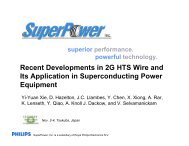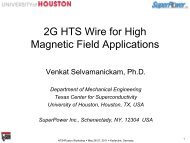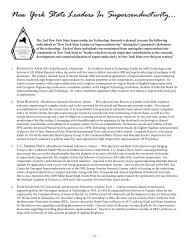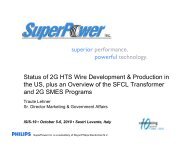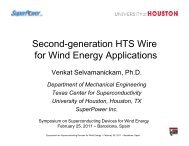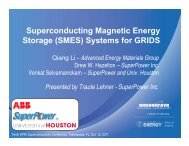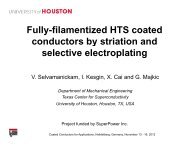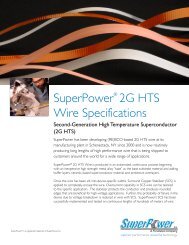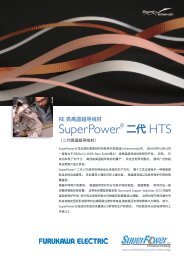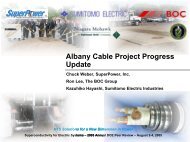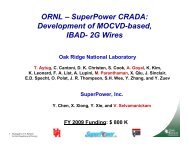superconductivity - CCAS - Coalition for the Commercial Application ...
superconductivity - CCAS - Coalition for the Commercial Application ...
superconductivity - CCAS - Coalition for the Commercial Application ...
You also want an ePaper? Increase the reach of your titles
YUMPU automatically turns print PDFs into web optimized ePapers that Google loves.
Superconductivity: Present and Future <strong>Application</strong>s<br />
Superconductor magnets are essential to this application because of <strong>the</strong>ir<br />
dramatically lighter weight and lower power requirements. At present, maglev<br />
train lines operating in Japan, Germany and China make use of low temperature<br />
superconductor (LTS) technology. However, <strong>the</strong>re is now research underway on <strong>the</strong><br />
application of HTS coils to maglev trains, which could result in lower cooling costs<br />
and higher stability.<br />
O<strong>the</strong>r HTS <strong>Application</strong>s and Ramifications<br />
O<strong>the</strong>r transportation systems could, in time, be powered by systems using<br />
superconductor wire. The focus of <strong>the</strong>se innovations however, is on large, bulk<br />
transport systems ra<strong>the</strong>r than individual passenger automobiles, which are used<br />
intermittently. The wider adoption of plug-in hybrid automobiles would result in<br />
increased total demand on <strong>the</strong> interconnected power grid and it is often noted<br />
that plug-in hybrid cars could provide a load-leveling function and lead to lower<br />
rates and more efficient grid asset utilization. If this concept becomes very<br />
commonplace, it will necessarily lead to an increase in total demand on <strong>the</strong> power<br />
grid, requiring upgrades to <strong>the</strong> general grid infrastructure. In certain locations,<br />
especially dense urban areas, this could necessitate <strong>the</strong> use of superconductorbased<br />
technologies in order to ensure <strong>the</strong> safe, reliable delivery of large amounts<br />
of power into dense urban areas.<br />
14<br />
The Foundation: Advances in HTS Wire<br />
The basis <strong>for</strong> <strong>the</strong> per<strong>for</strong>mance advantages of <strong>the</strong>se transportation technologies<br />
lies in high-per<strong>for</strong>mance superconductor wire. Electric shipboard motors<br />
employing superconductor wire can generate very powerful fields in a small<br />
fraction of <strong>the</strong> volume and weight of copper-wound motors. O<strong>the</strong>rwise, <strong>the</strong>y make<br />
use of conventional, well-understood designs, employing <strong>the</strong> same century’s<br />
worth of developments and refinements that apply to all AC synchronous electric<br />
motors. Maglev trains, likewise, make use of ultracompact, high-field coils that<br />
would be physically impossible to construct, absent <strong>the</strong> miraculous property of<br />
<strong>superconductivity</strong>.<br />
With worldwide supplies of oil under increasing pressure, <strong>the</strong>re is an<br />
urgent need to develop alternative solutions to ensure that economical means<br />
exist to move people and goods in <strong>the</strong> world of tomorrow. The phenomenon of<br />
<strong>superconductivity</strong>, which has found uses in applications ranging from research and<br />
medicine to electric power, could play a critical role in ensuring that <strong>the</strong>se pressing<br />
needs can be met.<br />
© 2009 <strong>CCAS</strong> : <strong>Coalition</strong> <strong>for</strong> <strong>the</strong> <strong>Commercial</strong> <strong>Application</strong> of Superconductors




